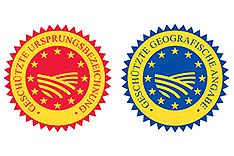Content
Amendments to opposition proceedings: What has changed since 14 January 2019

New system in opposition proceedings
Before the reform of trade mark law, each opposition filed had to be based on a single opposing sign. If the proprietor wanted to base his opposition on several opposing signs, several oppositions had to be filed. Since 14 January 2019, the proprietor of several earlier rights can assert them with a single opposition. As before, the DPMA can decide on several oppositions jointly.
New grounds for opposition

At the same time, the options for opposition have been extended. Pursuant to section 42 (2) no. 5 of the Trade Mark Act, an opposition may now also be based on
- protected geographical indications – PGI, and
- protected designations of origin – PDO.
However, these "additional grounds for opposition" can only be invoked against trade marks applied for on or after 14 January 2019, section 158 (3) of the Trade Mark Act.
Revised opposition fees
The opposition fee was adapted to the new, internationally uniform system and to reflect the increased time and effort involved. It amounts to 250 euros and - as before - includes one opposing sign. For each additional opposing sign claimed of the same proprietor, a further 50 euros must be paid.
New: "cooling-off" option
In order to facilitate negotiations between the parties to the proceedings, a period of at least two months is granted, at their joint request, to enable them to reach a friendly settlement ("cooling-off", section 42 (4) of the Trade Mark Act). This period may be extended by a joint request.
In contrast to EUIPO, "cooling-off" is not only possible at the beginning of the opposition proceedings, but at every stage of the proceedings. It is not granted ex officio but only upon joint request of the parties. In contrast to EUIPO, no fee refund is possible if the parties agree within the scope of the cooling-off period.
Amendments with regard to the objection of non-use
In opposition proceedings, the proprietor of the challenged trade mark may file an “objection of non-use”, see section 43 (1) of the Trade Mark Act.
In this context, a period of five years, known as the "grace period for non-use", applies to the opposing mark. The grace period for non-use now begins on the day on which filing an opposition against the registration of a trade mark is no longer possible. This is either the day after the expiry of the opposition period or the date on which the decision concluding opposition proceedings becomes final or the date of withdrawal of the (last) opposition. Previously, the grace period for non-use started upon the publication of the registration or – if an opposition had been filed against the registration – at the date when the opposition proceedings were concluded. Thus, the calculation of the grace period for non-use of the opposing mark is now in line with European Union trade mark law.
Due to the transitional provision of section 158 (5) of the Trade Mark Act, receipt of the opposition by the DPMA is crucial for the calculation of the grace period for non-use This means that the calculation may differ for the same opposing mark, depending on the date when the opposition was filed. Therefore, it is not possible to do an abstract calculation of the grace period for non-use.
Example: opposing mark "DPMA", registered in 2000
- receipt of the opposition before 14 January 2019: calculation according to "old law", section 158 (5) in conjunction with sections 26, 43 of the Trade Mark Act, former version
- receipt of the opposition on or after 14 January 2019: calculation according to current law, sections 26, 43 of the Trade Mark Act
Beginning of the period of use
Under the new law, the five-year period for which use of the opposing mark must be proved begins five years before the filing date or priority date of the challenged trade mark. Previously, this period began five years before the publication date of the registration of the challenged trade mark. The second, "moving" period of use of section 43 (1) sentence 2 of the Trade Mark Act (old version) has been repealed. However, cancellation proceedings due to revocation (new: "revocation proceedings") are still available for these cases.
Thus, the period of use to be proved now corresponds to the provision in European Union trade mark law.
| Receipt opposition until 13 January 2019 | Receipt opposition on or after 14 January 2019 | |
|---|---|---|
| Beginning of the grace period for non-use | Date of registration or date of conclusion of the opposition proceedings (becoming final) | Expiry of the opposition period + 1 day or date of conclusion of opposition proceedings (becoming final) |
| Objection of non-use admissible | Beginning of the grace period for non-use + five years | |
| Period of use for providing proof | 5 years before publication of the registration of the challenged trade mark | 5 years before filing date/priority date of the challenged trade mark |
| Second "moving" period of use | five years before the decision | repealed |
| Legal basis | sections 158 (5) Trade Mark Act, new version in conjunction with sections 43 (1), 26 (5) of the Trade Mark Act, former version | sections 43 (1), 26 (5) of the Trade Mark Act, new version |
In addition, there are the following changes in connection with use (section 43 (1) of the Trade Mark Act):
- According to previous trade mark law, it was sufficient for the opponent to substantiate the use of the opposing mark; now proof must be furnished. However, an affirmation in lieu of an oath is still allowed as proof.
- For trade marks whose application was filed with us as from 14 January 2019, the beginning and end of the grace period for non-use are shown in the register, see section 25 no. 20a of the Trade Mark Ordinance.
Initial experience gained
So far, the changes have functioned well in practice and there have been few problems during the transition. According to initial feedback, the redesigned forms for opposition proceedings have helped to avoid frequent formal errors and thus contribute overall to speeding up proceedings.
Opposition proceedings – tips
- Please note the transitional provisions, particularly with regard to questions on use!
- Use the current forms:
- current opposition form (W 7202),
- together with the annex for registered signs (W 7202.1)
- or/and annex for non-registered signs (W 7202.2)
- If you wish to surrender your registered trade mark during opposition proceedings, please always file a request for cancellation. This avoids additional clarification and delays. However, a request for withdrawal of your trade mark application is only possible prior to registration.
Bild: iStock.com/Nastco, DPMA
Last updated: 10 December 2025

Not only protecting innovations
Social Media